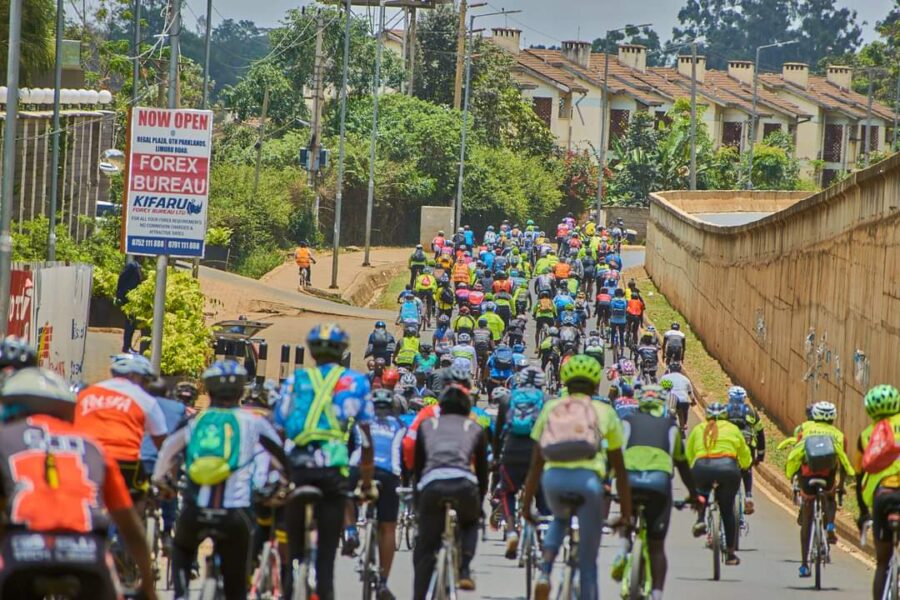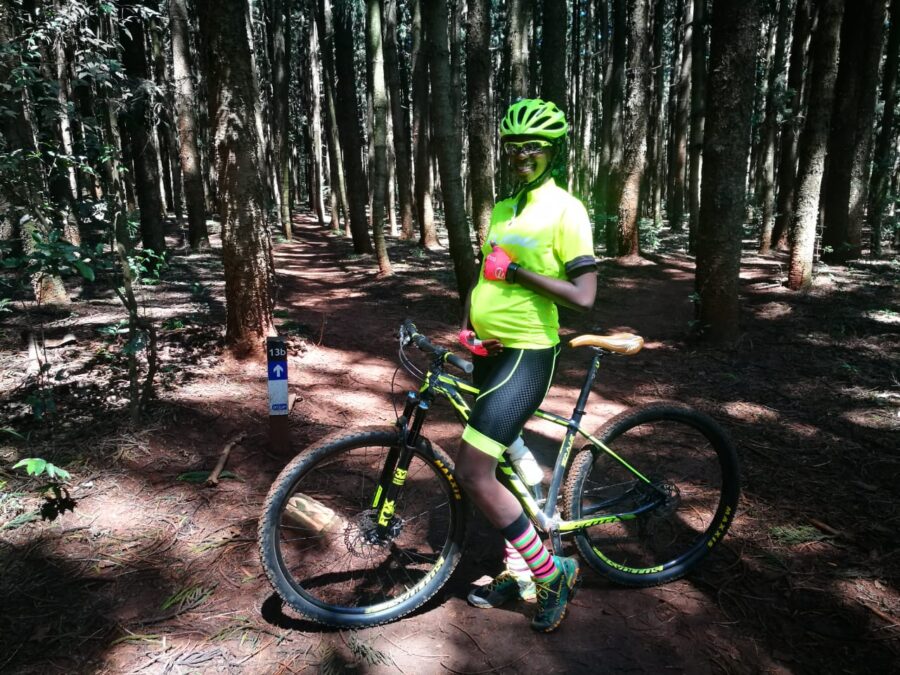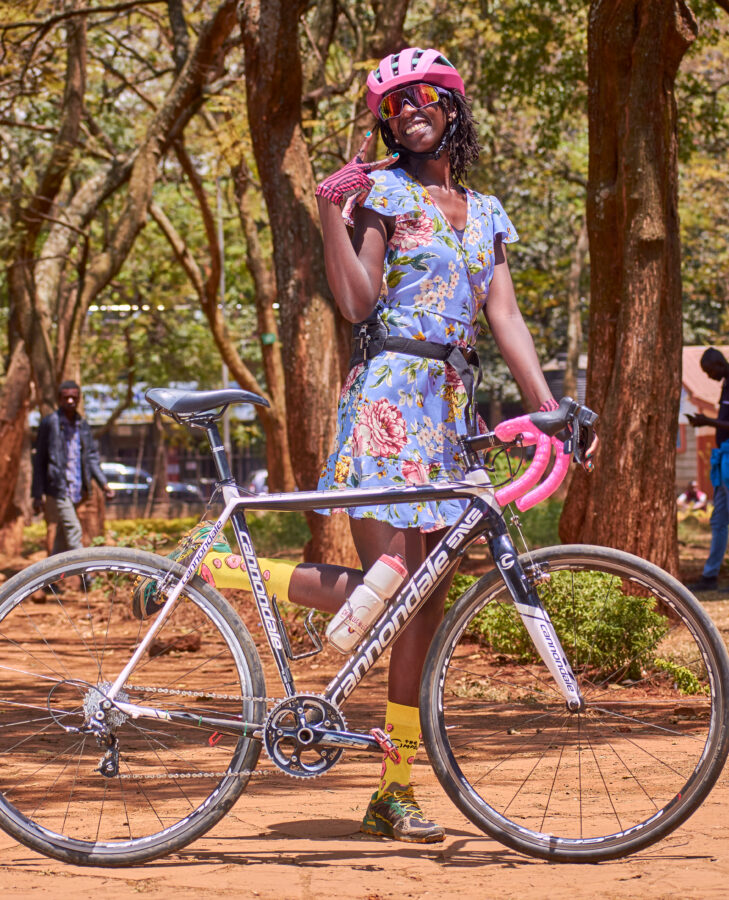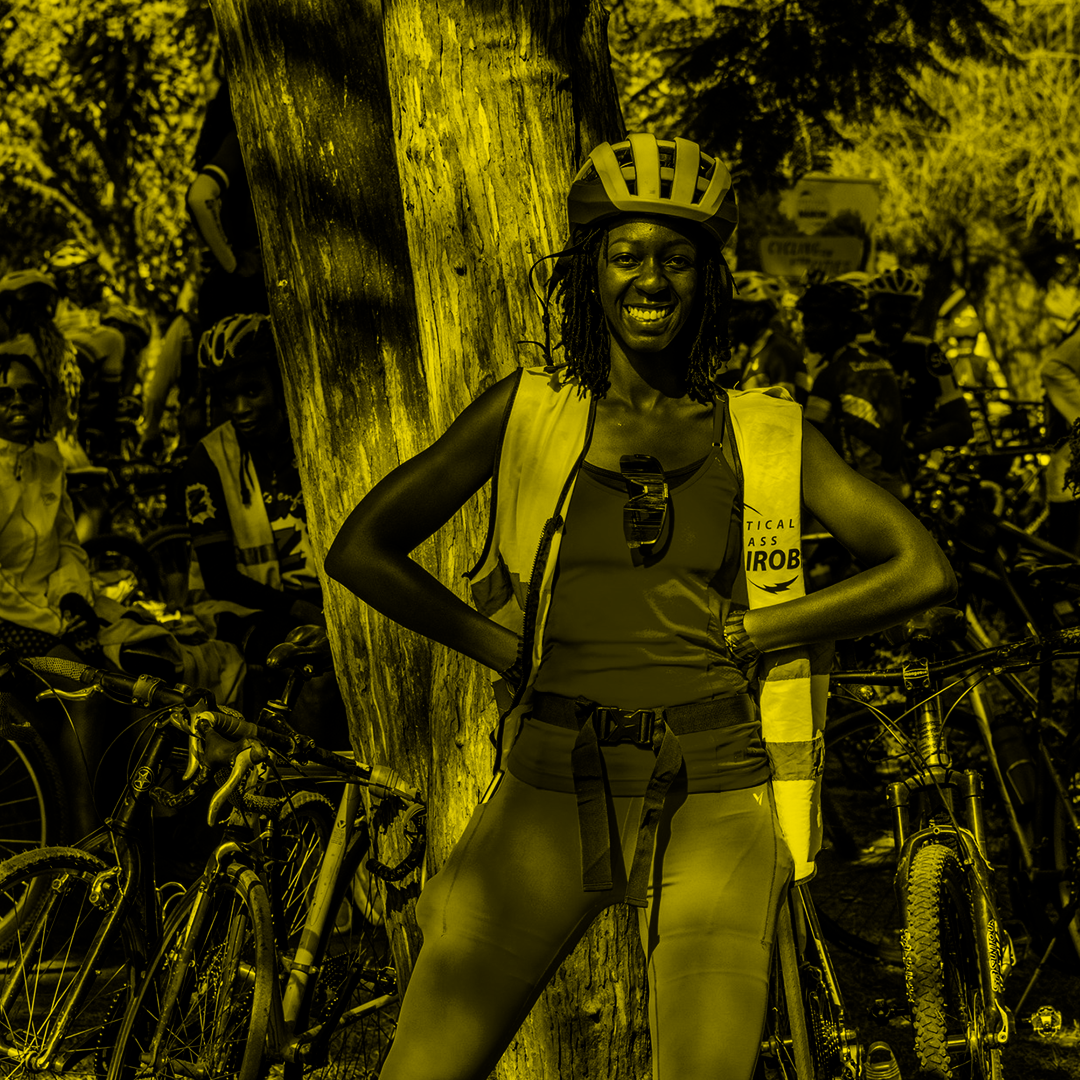Cyprine Odada is an urban planner and the Executive Director of Critical Mass Nairobi, a cycling movement in Nairobi, Kenya. With a passion for cycling and advocating for sustainable transportation, Cyprine has been instrumental in growing Critical Mass Nairobi into one of the largest non-competitive cycling movements in Africa. She believes in the power of cycling to bring communities together and has worked tirelessly to promote inclusivity and accessibility in cycling initiatives. Cyprine is also recognised as a remarkable feminist voice in transport, highlighting the intersection between feminism and sustainable transportation. Through her work, she aims to challenge cultural norms and create a safer and more inclusive cycling culture in Nairobi.
–
Congratulations on nearly a decade of Critical Mass Nairobi! What inspired you to start the initiative, and how has it evolved over the years?
There’s a gentleman who started critical mass in 2014 as a friendly cycling activity after work for a few friends. I joined critical mass in 2016 when I was basically looking for a community. I had just moved to Nairobi, I didn’t have friends, I was looking for work, so my stress levels were pretty high, and I could not afford a gym. So, I picked up my now husband’s really old bicycle and I started cycling in the neighborhood. I got this really amazing feeling and sense of purpose and that’s when I met the Cycling group. I was very happy to meet them because at that point I felt like I met my community, it was very seamless, I felt I belonged. So in 2016 after I joined, unfortunately, the group wasn’t meeting as often, sometimes with just five people – with time it just started dying. Sometimes we wouldn’t even have rides, so I asked the gentleman who was leading the group if I could help grow and help invite other people. I didn’t look at it as a movement, I just wanted to invite other people so that this community that I had met and this family that I had found wouldn’t disintegrate or wouldn’t stop meeting. So I took on the responsibility and started inviting other people, started organizing better rides, planning the ride routes and making sure there are enough stops. The movement part of it came in as I continued cycling at that point.
I feel funny saying this, but at that time I wasn’t proud of being an urban planner. I had actually denounced the profession because, as I was cycling, I could see all the mistakes urban planners were making. I felt very embarrassed. I felt ashamed. I did not want anybody to associate me with what I saw with my own eyes. That’s when it hit me. I could use critical mass as an avenue for me to voice my experiences and basically share the challenges that road users go through and so I started becoming more vocal about those challenges that I and other people were facing, so it helped me do a lot of the advocacy and I also realized that there are a lot of people who found solace in critical mass. It felt like a family and people wanted to join because many of them, just like me, did not have family in Nairobi. Through cycling with the big group, they found friends, they found relationship partners and their happiness came back. So, the joy that cycling was bringing just made people keep coming back.
But before we move on, let me just say: now I am an urban planning addict. I talk, sleep, eat and drink urban planning. I’ve seen the good, the bad and the ugly of urban planning, and I have learned a lot about the power of being an urban-technical person with personal experiences. So I now have learned how to put together my different hats and make urban planning more attractive and give it a positive light.
Critical Mass has been successful in bringing together people from diverse backgrounds. How do you approach inclusivity and accessibility in your cycling initiatives, especially considering the social and economic disparities in Nairobi?
In the beginning, when the movement was growing, we noticed that mainly those in the middle to higher income economic bracket were the ones coming and that was against everything that we stood for because we wanted everyone, including those who are in the lower income bracket, to attend the rides. So we started packaging our marketing materials in a way that would attract other people, not just those from the higher or middle income and also, sharing a lot of photos of our events has really worked for us is posting an image of somebody from a higher income bracket and a lower income bracket having fun and laughing and genuinely showing interest in each other. It was a very powerful tool, we didn’t have to convince people too much that these rides were for everyone; the photos were doing all the work for us.
The other thing that we really encouraged people to do was to talk to new people every time they came for the rides. We tried as much as possible to introduce people to newcomers. Also, the consistency of the rides made it something where friendships can develop versus having a ride once every three months, you know, so having been consistent and persistent really helped to solidify those friendships. But of course also just constantly reminding people that this is a social ride – we want people to have fun, that is the main goal! The advocacy is just a byproduct of the fun. And I think it really worked and today we have everyone, even someone who has the most rickety looking bicycle show up and they have a fantastic time and somebody who has a thousands of dollars worth of expensive bicycle has fun.
Another strategy that we adopted was going to different neighbourhoods every month. So when we plan the routes, we would mix and match different neighbourhoods. I think, till today, we’ve never actually repeated a route. We will just twist a turn and change the route and help make sure somebody who’s from one part of one neighbourhood is getting an experience in a different neighbourhood. One month we go to the slams, another month will be in a posh neighbourhood.
We never tell people where we are going because if I tell someone from a higher income bracket that we’re going to ride through a slum, they might not show up. So, we share the route the morning of the ride and at the venue, but never prior to the ride.
The only people we share the route with are the traffic police because they’ve been very instrumental in helping us have smooth, seamless manoeuvres around the city. It never used to be like that. We started sharing our routes with the traffic police in 2020 when our numbers skyrocketed. Before then we would have like a hundred cyclists, maybe 200. We didn’t feel the need to get extra support from traffic police, but when we started hitting the 300-400 mark every month, we realized that we were actually causing a lot of traffic for the traffic police. We also needed to make them our friends. They love the work we do and love seeing children, women, people of all age groups and different social economic brackets riding. They look forward to seeing cyclists on the road and it’s just an amazing thing to see when police wave at us when we are on site.
Do you also sometimes experience that people join while the rides are happening?
Yes. Oh, yes. We have people who run home and grab their bikes.
Most of our advertising is on our social media platforms, so if you don’t have a friend who cycles or if you don’t follow us on our social media platforms, you will not get to know about our events. Something that we’ve been intentional about is not to over Market the events and the rides. We tell cyclists if they love it, they will invite their friends. It is not upon me as Cyprine to invite your friend, if you feel a certain way about it, you will want your friends and family to experience it. So the cyclists themselves have been the greatest marketing tool for critical mass, not us. I think the last time I paid for an ad must have been in 2017. I don’t pay for ads. I’ve never posted anything in a newspaper. It’s mostly word of mouth and the posters that we share on our social media pages and our WhatsApp groups.
As an urban planner and a cycling advocate, what are some of the main challenges you face in promoting cycling culture in Nairobi and how have you addressed them?
We face different challenges and they come from different parties. Surprisingly enough, it is our own culture that is one of our biggest barriers to cycling, followed by our infrastructure. The reason why culture goes before infrastructure is because, through critical mass, we’ve been able to demonstrate that people will cycle regardless of how bad the infrastructure is. But more people would cycle if we have better infrastructure, so there’s a very large population of people who don’t cycle because of that reason, but our culture is in such a way that we are conditioned to aspire to own cars. Most people look when we are young we are told that car ownership is what signifies success. So a lot of people look forward to owning cars and if a cyclist would come they would automatically assume you’re poor or you are just going through a difficult time in life. Or you are a rich person just enjoying their leisurely activity. So culture has definitely been a big barrier.
We have several tribes in Kenya, and in some tribes women are not even permitted to cycle. It is considered at Taboo. It’s considered unladylike and they give a long list of excuses why women are not allowed to cycle. Trying to prove that you can be a successful woman, a woman who can be married and still cycle has been one of the biggest challenges, but the women who’ve been cycling over time have proven that you can have all these things, you know and still ride a bicycle. Getting where we are right now wasn’t easy, so many misconceptions and outright sexual harassment. Sometimes we’ve had to deal with so many cases of men women being sexually harassed by other road users. Sometimes even pedestrians would harass women so that has not been easy, but we also teach the female cyclist to have thick skin. We teach them to fight back, not physically, but to own their space and own their activity and be proud of it and do it regardless.
Maybe we can also touch on infrastructure a little bit because it’s also a very important barrier. Most of our roads do not have cycling Lanes or cycling infrastructure. Even the roads that have bike lanes are poorly designed and are quite dangerous to use. So, having good infrastructure is really important because it makes somebody feel safe and comfortable to cycle. Nairobi has been making some progress over the past few years with building more cycling lanes. They could be better, but it’s still a step in the right direction, I will give them that.
Your presentation at velocity focuses on transforming Nairobi into a cycling City, particularly highlighting the Nairobi bike trains. Can you tell us a bit more? How does this program work? And what impact has it had encouraging cycling as a transportation option?
I love discussing bike trains because it reminds me of how the idea came about. I was stressed due to the high increase in cyclists, our numbers were sky-rocketing but many were riding only once a month, which wasn’t ideal. Our goal was to encourage daily cycling, but a major challenge was that many cyclists didn’t feel safe riding alone. This is where the concept of critical mass became crucial — safety in numbers. People join our rides because they feel safe. To address this safety issue, we created smaller critical masses in different neighborhoods, which we call bike trains.

Currently, we have around 11 bike trains, each with its own WhatsApp group and a designated captain. Members communicate within these groups to plan rides or coordinate their commutes. Initially, we had a set schedule, but we realised people have varying weekly schedules. The schedule for bike trains has been especially successful for our critical mass rides. Instead of driving to the venue, people pick each other up along designated routes, attend critical mass together, and return home in the same bike train. Our largest group has 377 members, and the numbers are growing. In fact, our main WhatsApp group is currently full, with a waiting list in place.
The bike trains help accommodate those who cannot join the main group. We also have our cycling marketplace, which is full and has a long waiting list. However, the bike trains have been really effective in getting women and children to cycle because they are riding with their neighbors and community, which makes them feel comfortable. Additionally, for those who want to commute to work, it’s easy because they can plan a ride with someone commuting in the same direction. So, that’s it.
I want to touch back on something. We were speaking earlier about a topic on women. Your work has been recognized as a remarkable feminist voice in transport, how do you see feminism intersecting with the promotion of sustainable transportation? And what advice would you give other women advocating for change in this field?
I realized that, as a woman, I bring very different experiences from men, and those experiences rarely make it to the decision-making table. When I was cycling while pregnant, I noticed that many challenges women face are not recognized or addressed. For me, feminism in transport means sharing the daily experiences of women and ensuring they are recognized and addressed. Many women are suffering and are often told to toughen up or assume that transport experiences are the same for men and women, which they are not.
In most societies, women are the primary caregivers. Caregiving is not easy. Walking from your house to a child’s school a few kilometers away is a very different experience than walking alone, especially with active children. These unique experiences often go unnoticed. Feminism in transport is about telling transport planners and policymakers that they must recognize the experiences of women. It’s unfair that in 2024, we still consider safe footpaths a luxury when they should be a basic right.

More people, not just women, need to recognize the gender aspect in designing transport systems. Feminism in transport is not just a women’s issue; it’s everyone’s issue. For example, if a husband knows his wife cannot walk comfortably, or if his daughter feels unsafe going to school, he should be concerned. These issues are often overlooked, and we must bring them to the forefront.
Another point I always emphasize is that it’s not about a male versus female argument. Instead, it’s about creating a system that works well for women, which in turn tends to benefit men too. Men should actively support this agenda because it will also enhance their mobility, making it easier and safer for everyone.
Including women does not mean excluding men.
Absolutely, I often ask men to imagine that I’m not me, but their daughter, advocating for the same things I am. If they could see my face and replace it with their daughter’s, wife’s, or mother’s face, asking for better street lighting, lower speeds, or wider sidewalks, their perspective would likely change. Sometimes, the messenger is unfairly criticized, but this is a shared responsibility. We need men actively engaged in advocating for a transportation system that truly meets the mobility needs of women.
What advice do you have for other women advocating for changing the field?
Don’t give up. It’s not easy. Advocates of better transport system more often than not have already put themselves in this role model pedestals, there are a lot of young girls and even young boys who look up to us as Role Models, so as much as we are doing something that we love, we are paving the way for other generations – and we cannot give up. It’s not easy always asking for more and always calling out poor designs. But if we give up, everybody else who’s behind us might also give up. We are a beacon of hope for a lot of women who are voiceless. We are their hope so we have to keep fighting for better Transport Systems, walking, cycling and public transport. We do it because a lot of people’s voices have been stifled. They’ve given up. So we have to be brave, we have to be tough. We have to show up for such calls and share this information as much as possible.
Something that I decided to do this year is I am trying as much as possible to say less no. I am saying yes to a lot of things, a lot of speaking opportunities because I realized that there are very few women in transport and our voices are more often than not at the bottom tier. We have to keep talking, we have to keep showing up so that we keep getting recognized and our voice keeps getting Amplified. I personally am trying to say yes to a lot of things that would allow me to amplify the messages that I’ve been sharing for us for so many years but to everyone else on this train, we can’t give up. There is a very big community of people who are looking at us hoping that we would provide the solutions to the challenges that they’re experiencing.

What are your goals and your aspirations for the future of cycling in Nairobi?
For Nairobi specificity, I think having a policy for cycling would be very important. I think advocacy is fantastic, but advocacy that is not supported by a policy is very weak. So my hope is to have a team of cycling experts, hopefully in the near future, who I can help put together a policy draft for advancing cycling in Nairobi. We’ve recently developed an immobility policy for Kenya. And the time that it took to do that was very short compared to most other policies. If we can do it for immobility, we can definitely do it for walking and cycling.
Are there any points that you would still like to address? Perhaps something that you feel like is worth mentioning that I didn’t touch upon?
So something very simple that I have been telling a lot of cyclists is to keep sharing your experiences and inviting your close friends to be ambassadors. Let them experience what you’re experiencing and ultimately make the transition to cycling cities much easier. It’s a tough fight when we are trying to push for cycling cities or safer streets, but the community is still very much linked to motorized transport, so invite your nearest community to make them experience what you’re experiencing and soon we will have more cycling cities!
If everyone adopted that mindset, eventually it will be shared with everyone.
Exactly, eventually we will find the minister of Transport’s son fall in love with cycling and he’ll go to his father and say “dad, I need you to start cycling.” The roots can easily be spread if we share the joys of cycling. It will reach the right person one day.

